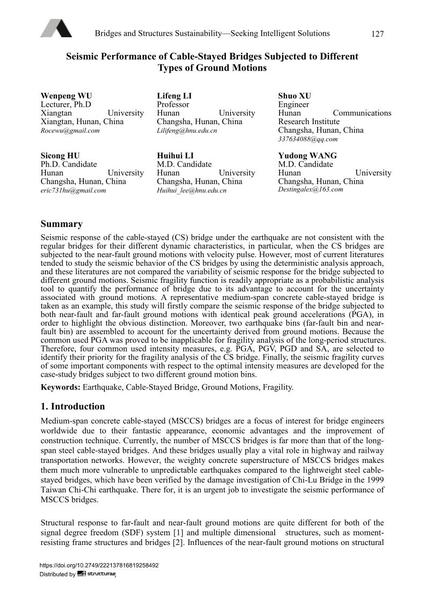Seismic Performance of Cable-Stayed Bridges Subjected to Different Types of Ground Motions

|
|
|||||||||||
Bibliographic Details
| Author(s): |
Wenpeng Wu
Sicong Hu Lifeng Li Huihui Li Shuo Xu Yudong Wang |
||||
|---|---|---|---|---|---|
| Medium: | conference paper | ||||
| Language(s): | English | ||||
| Conference: | IABSE Conference: Bridges and Structures Sustainability - Seeking Intelligent Solutions, Guangzhou, China, 8-11 May 2016 | ||||
| Published in: | IABSE Conference, Guangzhou, China, 8 – 11 May 2016 | ||||
|
|||||
| Page(s): | 127-135 | ||||
| Total no. of pages: | 9 | ||||
| Year: | 2016 | ||||
| DOI: | 10.2749/222137816819258492 | ||||
| Abstract: |
Seismic response of the cable-stayed (CS) bridge under the earthquake are not consistent with the regular bridges for their different dynamic characteristics, in particular, when the CS bridges are subjected to the near-fault ground motions with velocity pulse. However, most of current literatures tended to study the seismic behavior of the CS bridges by using the deterministic analysis approach, and these literatures are not compared the variability of seismic response for the bridge subjected to different ground motions. Seismic fragility function is readily appropriate as a probabilistic analysis tool to quantify the performance of bridge due to its advantage to account for the uncertainty associated with ground motions. A representative medium-span concrete cable-stayed bridge is taken as an example, this study will firstly compare the seismic response of the bridge subjected to both near-fault and far-fault ground motions with identical peak ground accelerations (PGA), in order to highlight the obvious distinction. Moreover, two earthquake bins (far-fault bin and near- fault bin) are assembled to account for the uncertainty derived from ground motions. Because the common used PGA was proved to be inapplicable for fragility analysis of the long-period structures. Therefore, four common used intensity measures, e.g. PGA, PGV, PGD and SA, are selected to identify their priority for the fragility analysis of the CS bridge. Finally, the seismic fragility curves of some important components with respect to the optimal intensity measures are developed for the case-study bridges subject to two different ground motion bins. |
||||
| Keywords: |
fragility earthquake: cable-stayed bridge: ground motions
|
||||

